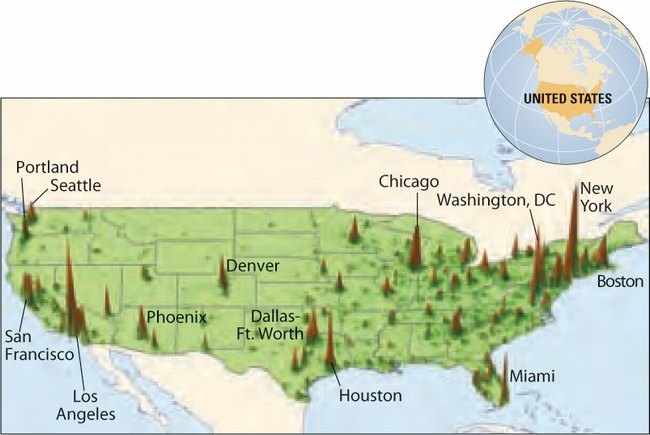
Cities experiencing very high or negative population growth rates betwen 1990 and 2000. Source: UN-HABITAT State of the World´s cities 2008/2009
Urban sprawl, the concept of the single family house on an individual plot of land serviced by private car transport combined with accessible shopping centres remains high on the agenda. The implication is that the cities grow in terms of area. This is as typical of Dar es Salaam or Nairobi as it is of Paris, Lyon, Helsinki or Oslo. In fact many of the new cities being planned in China are being specifically designed and developed with these very models in mind.
The global urban population is currently growing by nearly 60 million people every year, indeed, every second person now lives in a city with the global population now above six billion. Only four of the world's largest 25 cities, however, are situated in the rich countries.
A century ago only two out of ten people lived in urban areas. In the least developed countries figures were as low as 5%. The total population of the world was then around two billion people.
In the coming years virtually the whole of the world's demographic growth, some 90-95% of it, will be concentrated in urban areas primarily in the cities of the 'south'.
By 2050, according to the latest UN-Habitat scenario, the world will have a total of almost nine billion inhabitants almost 70% of whom will be urban dwellers. Perhaps as much as a third of these people will live in slums or so-called 'informal settlements'.
High growth is expected for half the urban areas in the developing world during the coming twenty years. However, 11% will see regress and 16% only slow growth.
Many cities in the south like Nairobi, Dar-as-Salaam Marrakech, Lagos, Tijuana, Phnom Penh and pre-earthquake Port-au-Prince see growth at around 4% annually. That means that their population will double in 17 years.
However some cities, like Kigali in Rwanda and Shenzhen and Xiamen in China may double in only eight to ten years. China is also planning to build 100 cities with a population of one million each within the coming years.
A key feature of this future will be the melding together of mega-cities and their coalescence into mega-regions reaching population concentrations of more than 100 million people - called the 'never-ending´ city. Hong Kong together with Shenzhen and Guangzhou may soon become the largest city-conglomeration on the planet with 120 million inhabitants.
Cities in Europe and North-America will, at best, remain static in population terms. Indeed, in Europe more than half will continue to decline.
Some cities in Africa, Asia and Latin-America, such as Rabat, La Paz, Belo Horizonte, San Luis Potosi, Dengzhou, Madurai, Bandung and Manila are also likely to see a population contraction.
In 2005 the developed world had an urban population of 900 million. By 2030 it is likely to have reached one billion and by 2050 1.1 billion. Two thirds of this growth will be caused by migration both 'legal' and 'illegal'.
Nevertheless, it is highly likely that the population of at least 46 countries will continue its downward spiral. Germany, Italy, Japan, most of the former Soviet Union and several small island states will follow this trend.
The pace of global urbanisation is generally not accelerating. The decade with the highest relative expansion was the 1950s with an annual growth of over 3%. For 2025-2030 overall urban growth is likely to be 1.5% per year.
Moreover, overall population growth is declining. Developing countries which had an annual growth of 4.2% on average in the early 1960s are expected to fall to 1.25% by 2050.
In Europe during the period 1996-2001, one third of all cities saw notable declines, one third were stable and one third grew a little, perhaps by +0.2% annually.
Currently some 70% of the EU-27 population live in urban areas, however, only 7% live in a metropolis of more than five million inhabitants. The equivalent figure for the US is 25%.
In cities like London, Paris, Berlin, Madrid and Rome between 80% and 90% work in the service sector. Europe has almost 1000 cities with more than 50 000 inhabitants, 6000 towns or cities have more than 5000 people.

Graphical presentation of economic production per square kilometre in the United States highligting the role of the cities.
Source: WDR 2009 team and World Bank Development Research Group based on subnational GDP estimates for 2005.

Urban population (millions) by region, 2005 and 2050. Source: UN-HABITAT State of the World´s cities 2008/2009

Total global population develoment trends. Source: UN-HABITAT State of the World´s cities 2008/2009
By Odd Iglebaek